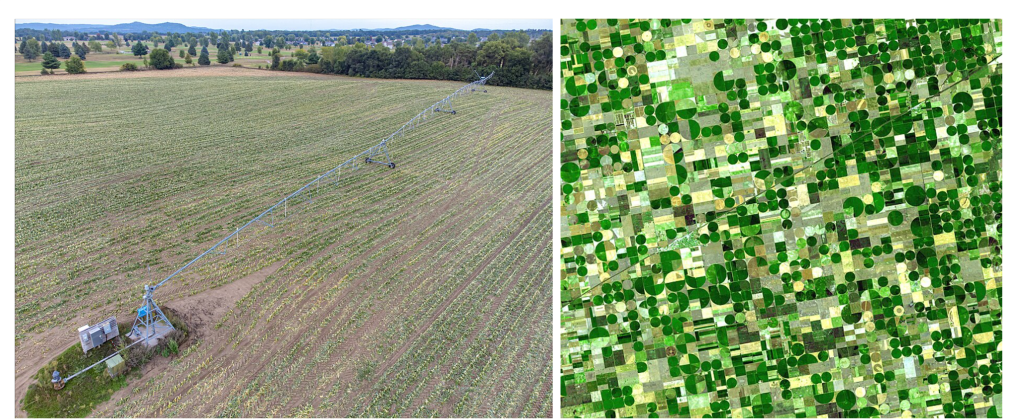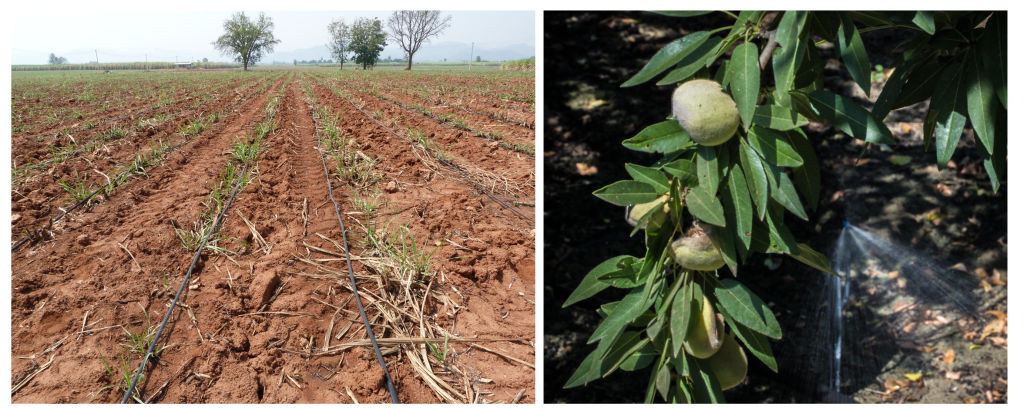2. Strategies for Preventing Scarcity
As discussed in Chapter 2B, water storage supplied by dams plays an important role in combating water scarcity by storing surface water for major cities and agriculture worldwide. However, the negative impacts associated with dams means that few new dam construction projects are being proposed or approved, and many old dams are being decommissioned. Instead, alternative solutions are being implemented that provide more environmentally friendly solutions. These solutions focus around increasing the supply of water or using water more sustainably (i.e., decreasing water withdrawals).
2.1 Increase water supply
Sand Dams
One method of increasing water availability in arid regions is by using sand dams. These are a rainwater (or snowmelt) harvesting technique in areas with sandy soil and ephemeral streams (streams that flow only briefly in localized areas following heavy rainfall or snowmelt). A small, reinforced concrete wall is built across an ephemeral stream channel and during heavy rainfall, water erodes the soil and surface runoff transports the soil into the stream channel. The sand settles behind the dam wall, but the silt and clay sized particles remain suspended and are transported with the water as it flows over the wall. Over time, sand deposits fill the space behind the dam until they are level with it. This can take anywhere from 1 rainy season to many years depending on erosion rates in the area. This built-up area of sand is the sand dam (Figure 2C.2.1). During rainfall and surface runoff events, water infiltrates into the sand dam to be stored in the pore space, where it can be used by local communities for domestic and agricultural purposes when it is dry. This also allows the water to infiltrate more easily and replenish deeper aquifers. Sand dams are a way of creating a thicker artificial surface aquifer to store water in dry regions. This helps protect water from evaporation, can improve local ecosystem health by supplying much needed water, and can improve local communities by increasing access to water and decreasing time needed to collect water from far away sources.

Sand dams are mainly utilized across large regions of Sub-Saharan Africa and India but there are some in the United States as well, mostly in the desert southwest. They are simple and low-cost structures that require minimal maintenance and can be built within a handful of months. This differs from large dam projects which are very expensive, require constant maintenance and take many years to build.
Groundwater Recharge Systems
Groundwater recharge systems are another method of artificially increasing water table elevations. This can be done by redirecting water through canals or ditches to land areas that have been set aside to be used as infiltration basins. These land areas are chosen such that they have adequate porosity and permeability to allow for easy infiltration of water. To recharge deeper aquifers, water can be injected deep into the subsurface through wells. This can be useful for capturing winter storm moisture and spring snowmelt (when agricultural need for water is low) and storing it for the growing season. These techniques are being used in San Joaquin Valley, California to combat the groundwater depletion occurring there due to intensive agriculture.
Rainwater Harvesting
A method that is particularly useful in urban areas is harvesting rainwater. This is done by collecting rainwater that runs off buildings and can be done on a small scale, such as having a rain barrel to collect runoff from a house roof to store and use as water for a lawn or garden, but can also be scaled up to very large collection systems that harvest rainwater runoff from large buildings or building complexes. Rainwater harvesting is useful in urban areas because buildings and concrete have greatly reduced the ability for water to infiltrate and recharge groundwater. Using collected rainwater can offset withdrawals from underground aquifers or surface water used in municipal water supply systems. The Velodrome constructed for the 2012 Summer Olympics in London utilized a rainwater collection system across half of its roof. This reduced the need for municipally supplied water by 40%!
Check your understanding: Sand dams
2.2 Decrease water withdrawals
While there are many options for reducing residential and industrial water usage (high water efficiency appliances, shorter showers, xeriscaping, etc.), the largest consumptive use of water is agriculture, therefore focusing on decreasing agriculture usage has the largest impact to overall water sustainability.
Irrigation Type
Surface Irrigation
Surface irrigation, also called flood irrigation, is the least efficient manner of irrigation. Flood irrigation involves water being supplied by canals, or pipes to the field, then allowed to flood across the field, flowing and ponding among the crops (Figure 2C.2.2). Flood irrigation is a “low-tech” method that is simple with minimal operating costs and often uses less energy than other irrigation methods. However, as this technique requires fields to be fairly flat and smooth so water will flow across the field without collecting in small pockets, it requires a large amount of labor for initial set up, operation, and maintenance. This technique is useful for large agricultural fields and pastures that are relatively flat lying.

As the name implies, this technique floods a field with water, applying far more water than is needed by the plant. Some of the water gets used by the plant, but substantial amounts also evaporate or infiltrate deep into the ground becoming groundwater, where it is out of reach of the plant’s roots. There is also a
lot of surface runoff with this method, which carries away both soil and nutrients leading to increased need for soil augmentation and creating water quality issues. Another problem with flood irrigation is that the water is not always applied evenly to all plants; some plants might get too much water while others get too little. In water stressed areas, this is a highly unsustainable method of irrigation, with application efficiencies ranging from 30% – 50%.
Sprinkler Irrigation
Sprinkler irrigation applies water to soil by spraying water through the air. Water is pressurized and delivered to the sprinkler system pressurized from a main pipe which is typically buried so as not to interfere with or be damaged by farming operations. This type of system is useful for large agricultural fields, pastures, orchards, and vegetables.
There are a variety of types of sprinkler irrigation systems, but the most common type across the U.S. is center pivot. It uses a central pipe that feeds the sprinklers which are set out across the field on wheels (Figure 2C.2.3, left). These slowly rotate around the central pipe making a large circular pattern of watered field. This system is responsible for the large circular farm fields seen as you fly over the country (Figure 2C.2.3, right).

Sprinkler irrigation requires higher up-front and operating costs than flood irrigation due to the purchase and maintenance of sprinkler systems and underground pipes. Maintenance involves cleaning sprinkler nozzles of built-up debris to keep them working properly and keeping pipes connected and leak free. There is also a moderate amount of labor involved to set the system up initially, but minimal day-to-day labor is required to keep the system working as it is often automated.
Sprinkler irrigation is often more efficient than surface irrigation because water application is more controlled; water is being directed down onto the plants not just flooding everywhere in a field. In hot and/or windy areas, however, sprinkler irrigation can have significant water losses due to evaporation and wind drift. Not all crops are suited to sprinkler irrigation as the spray can be quite powerful and may damage more delicate plants. Application efficiencies in sprinkler irrigation range from 75% – 85%.
Microirrigation

Microirrigation systems are used for many crop types. Drip irrigation is useful for field crops, fruits, and vegetables planted in long rows. Microsprinklers are popular for permanently installed systems that target individual plants such as in vineyards and orchards and useful for delicate fruits and vegetables as the low pressure will not cause damage. These systems are typically automated so that water is applied frequently (e.g., daily or multiple times per day) to maintain soil moisture. This promotes plant health by preventing overwatering or drying out between watering. Because water is applied directly to the crop plants, it also reduces weed growth which can compete with crops for water and soil nutrients.
While the upfront costs of this irrigation type are the highest of any type, they are the most highly efficient way to use water, which means less water is needed to get the same crop yield from a field. This means long-term savings in water costs that can make up for the high upfront costs. Application efficiencies for microirrigation range from 80% to over 95%.
The table below summarizes costs, labor requirements, and application efficiency of the three irrigation types.

Check your understanding: Irrigation types
Crop Choice
Soil Health
Cover Crops
Cover crops are mixtures of crops like grasses, small grains, and legumes that are planted in and around the crop being sowed/harvested (Figure 2C.2.6). They cover the ground to prevent any open soil on a farm field, which helps prevent soil loss through runoff and keeps the soil cooler thereby reducing water lost to evaporation. The increased plant cover also decreases surface water runoff allowing more water to infiltrate into the root zones of the crops where it can be used. Cover crops also suppress weed growth which can compete for water and nutrients. As the cover drops die and decompose, this adds organic matter and nutrients to the soil and improves soil structure by creating more loose, open soil which absorbs and holds water more effectively.

Certain cover crops also help bind nutrients back into the soil. Clover and legumes (like peas and beans) are particularly useful for this as they are “nitrogen fixers”. They bind nitrogen from the air and “fix” it into a form required for plant growth. Nitrogen is an essential component for growth and is one of the main components in commercial fertilizers. Using legumes as a cover crop can help reduce the need for fertilizer application.
Conservation Tillage
Conservation tillage practices are no-till or low-till practices where farm fields are not completely plowed up at the end of the growing season (Figure 2C.2.7). With conservation tillage there is minimal tilling that is confined to specific rows where planting will happen. This allows cover crop and other crop residues to stay on the surface and continue to protect the soil outside of the growing season reducing wind and water erosion of the soil. Like the practice of cover cropping, plants remain in place and roots break down adding nutrients and organic matter to the soil and improving soil structure, so soil better absorbs and holds water.

References
Bjorneberg, D. (n.d.). Some Information About Irrigation. United States Department of Agriculture. https://www.ars.usda.gov/ARSUserFiles/20540000/k12/irrigation.htm#:~:text=Application%20efficiency%20can%20be%20greater,to%2050%25%20for%20surface%20irrigation.
Creech, E. (2017). Saving Money, Time and Soil: The Economics of No-Till Farming. United States Department of Agriculture, Natural Resources Conservation Service. https://www.usda.gov/media/blog/2017/11/30/saving-money-time-and-soil-economics-no-till-farming
Richardson, J., (2023). Large Scale and Commercial Rainwater Harvesting. The Renewable Energy Hub UK. https://www.renewableenergyhub.co.uk/main/rainwater-harvesting-information/large-scale-commercial-rainwater-harvesting
